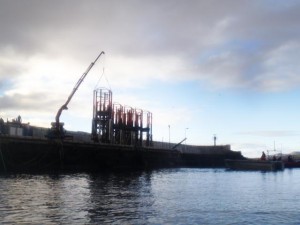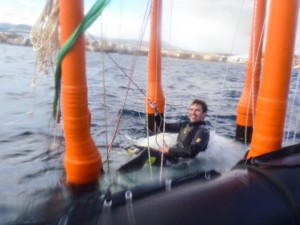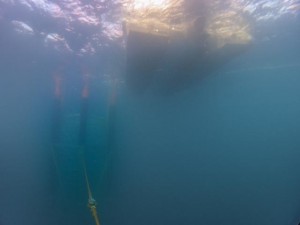Let´s start with the first task a diver has to do at the mesocosms, the first of many.
Of course everything begins with putting the mesocosms in the water. This is not done by the divers but by a crane, we only have to be there on call, if some lines get entangled.
Next is lowering the plastic bags from the boat till they are totally stretched out, by this they are filled with the surrounding water. Since the bottom and top opening are then below the water surface, they were covered before by a net with 3mm mesh size, so only smaller organisms can enter, eg algae and copepods have no problem, a young fish larvae may also fit through with the head first.
After lowering the lower end of the bag to 17m depth the divers attach the sediment trap at the lower end of the bag, called flange. One part of the flange creates a hinge together with the counterpart from the sediment trap.
With two divers this usually takes around 10 minutes per mesocosms, and there is 9 of them, the sediment traps end at 19m, 9×10 minutes in this depth can only be managed either by two divers with a rebreathing system or with 2×2 divers breathing Nitrox, an oxygen enriched air mix.
When there is two divers in the water, you also need a rescue diver, a person in charge plus somebody for communication with the divers, so you need 5 people out on the boat for every “big” task at the mesocosms.
The sediment trap is the conical base of the bag, with an attached tube reaching to the surface to pump the sediment.
The second step, a day after, is to take the nets off to seal the sediment trap tightly to the mesocosms flange. This, as well, is easiest done by two divers: one taking the net off and the other starting to close the flange already. Afterwards the upper opening can be pulled over the water surface level more than a meter to create a barrier against waves.
After putting in some weights at the sediment traps tip to make it a straight funnel, the mesocosms is ready to be sampled.
Additional tasks are more in terms of maintenance, like checking the pylons, ropes and bags for damages and putting in stronger connection lines between the mesocosms and the boys going to the ground weight.
Further into the experiment an additional task will be cleaning the mesocosms from outside to prevent shading by algae growing on the bags outside. From inside the bags are not cleaned by divers, but by a cleaning ring, which works like a window squeegee.


